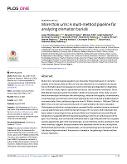More than urns: A multi-method pipeline for analyzing cremation burials

Autor
Waltenberger, Lukas
Bosch, Marjolein D.
Fritzl, Michaela
Gahleitner, Andre
Kurzmann, Christoph
Piniel, Maximilian
Salisbury, Roderick B.
Skerjanz, Hannah
Verdianu, Domnika
Snoeck, Christophe
Kanz, Fabian
Rebay-Salisbury, Katharina
Datum vydání
2023Publikováno v
PLoS OneRočník / Číslo vydání
18 (8)ISBN / ISSN
ISSN: 1932-6203ISBN / ISSN
eISSN: 1932-6203Metadata
Zobrazit celý záznamKolekce
Tato publikace má vydavatelskou verzi s DOI 10.1371/journal.pone.0289140
Abstrakt
Burial rites of archaeological populations are frequently interpreted based on cremated remains of the human body and the urn they were deposited in. In comparison to inhumations, information about the deceased is much more limited and dependent on fragmentation, selection of body regions, taphonomic processes, and excavation techniques. So far, little attention has been paid to the context in which urns are buried. In this study, we combined archaeological techniques with anthropology, computed tomography, archaeobotany, zooarchaeology, geochemistry and isotopic approaches and conducted a detailed analysis on a case study of two Late Bronze Age urns from St. Polten, Austria (c. 1430 and 1260 cal. BCE). The urns were recovered en-bloc and CT-scanned before the micro-excavation. Osteological and strontium isotope analysis revealed that the cremated remains comprised a young adult female and a child that died at the age of 10-12 years. Both individuals had been subject to physiological stress and were likely local. Animal bones burnt at different temperatures suggested different depositional pathways into the urn and pit as part of the pyre, food offerings, and unintentional settlement debris. Eight wild plant and five crop plant species appeared as part of the local landscape, as food offerings and fire accelerants. Sediment chemistry suggests that pyre remains were deposited around the urns during burial. Multi-element geochemistry, archaeobotany, and zooarchaeology provide insights into the Late Bronze Age environment, the process of cremation, the gathering of bones and final funerary deposition.
Klíčová slova
animals, anthropology, archaeology, Austria, burial, child, cremation, humans, young adult
Trvalý odkaz
https://hdl.handle.net/20.500.14178/2397Licence
Licence pro užití plného textu výsledku: Creative Commons Uveďte původ 4.0 International







